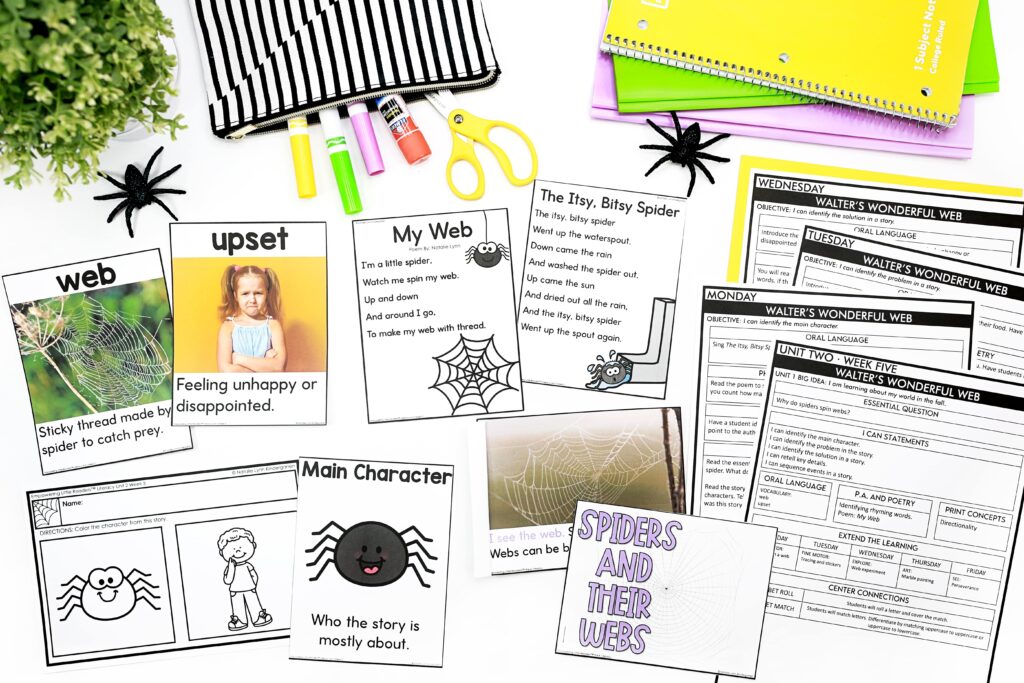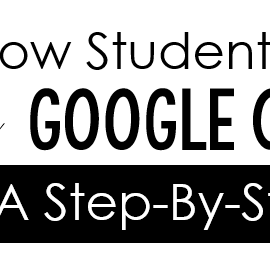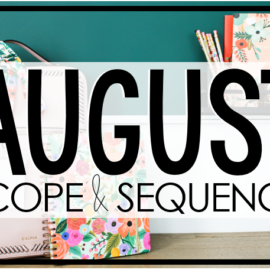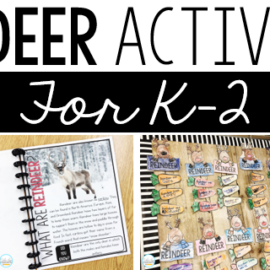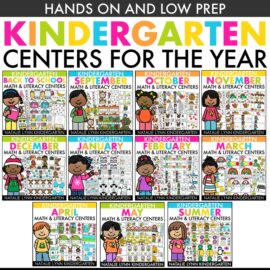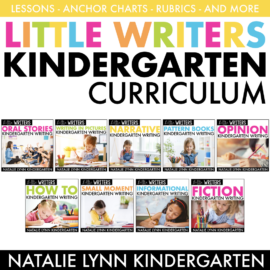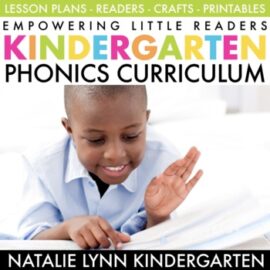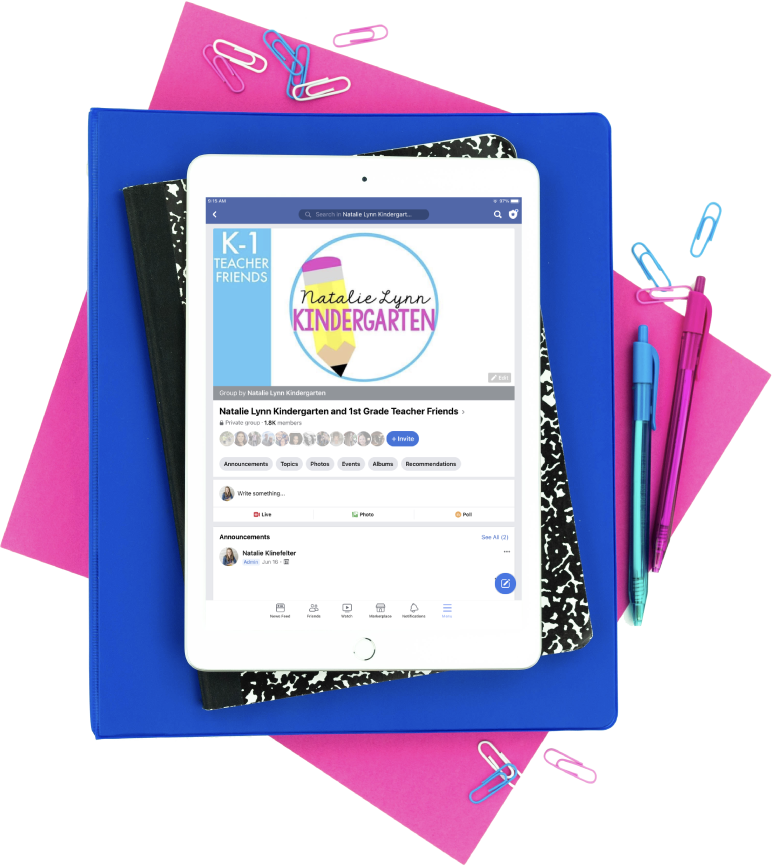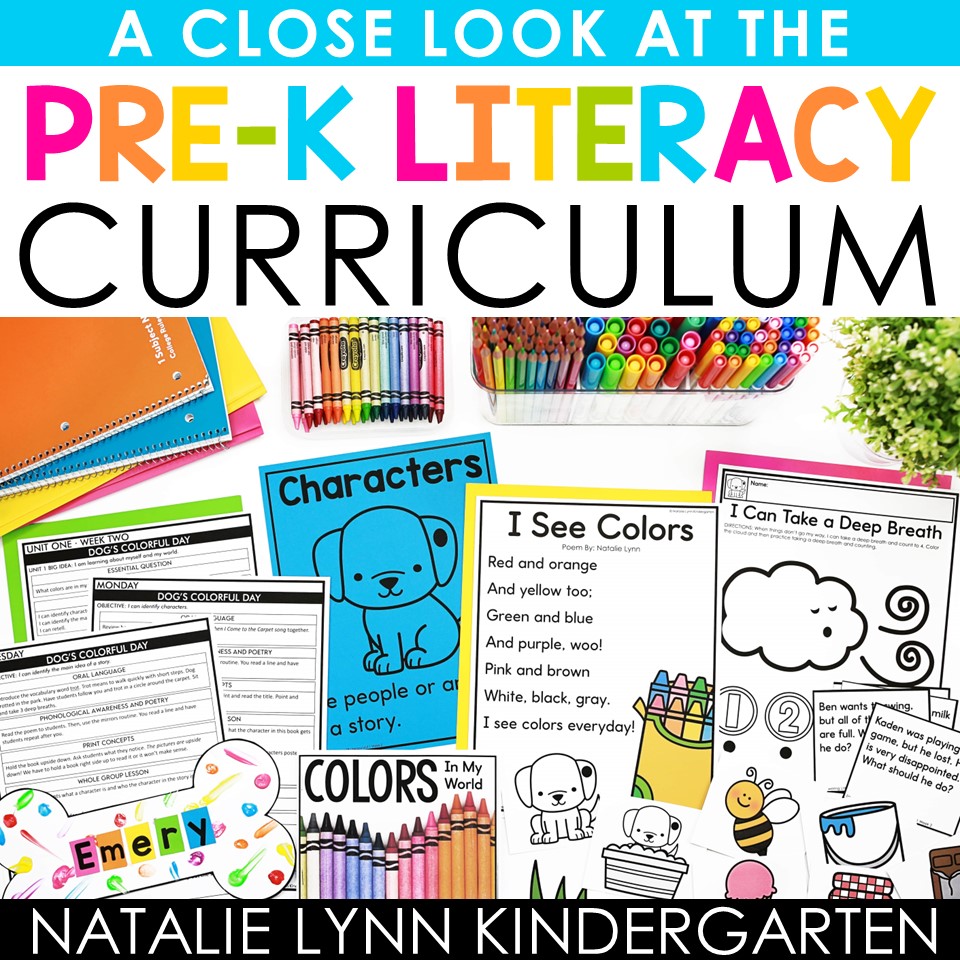
In this blog post: Take a closer look at the Empowering Little Readers Preschool and Pre-K Literacy Curriculum, which includes everything needed for read aloud lesson plans for preschool teachers.
The idea of teaching literacy whole group in preschool or pre-k can feel like a monumental task.
How do we build a strong literacy foundation while staying developmentally appropriate? How do we build comprehension skills for students who are not yet ready to ready?
When I began writing the Preschool and Pre-k Literacy curriculum, I knew it was going to be a big task. After all, we’re combining explicit literacy instruction with age-appropriate FUN!
What we ended up with is a unique approach to teaching early literacy skills that teachers have found both engaging and successful.
I adore this curriculum! I love that it lays out all the different areas of literacy instruction and has activities that are accessible and adaptable for my special education class.
Kylie C.
Below, we’ll take a closer look at all that’s included in these read aloud lesson plans for preschool teachers.
About the Preschool and Pre-K Literacy Curriculum
When I created the Preschool and Pre-K Literacy Curriculum, I wanted to write easy to follow read aloud lesson plans for preschool teachers to be able to build strong literacy skills for their students.

I knew this would be SO important as for many this will be the foundation of their literacy development.
This curriculum covers a little bit of everything – from oral language, shared reading, phonological awareness, print concepts, comprehension, and writing – which allows teachers to feel confident that they’re bringing their very best instruction to class each day.
That’s what we all ultimately want, right? To be sure that we are providing the young children in our classrooms with the tools that they need to possess a love of reading, develop their language skills, and build content knowledge that they will carry with them for years to come.
This curriculum can help you do that. Let’s check out the components of these read aloud lesson plans for preschool below.
Curriculum Overview
The Preschool and Pre-K Literacy Curriculum includes 6 main units, and each unit covers a Big Idea. The Big Ideas include:
- My World: I am learning about myself and my world.
- My World in Fall: I am learning about my world in the fall.
- My World in Winter: I am learning about my world in the winter.
- Tales From My World: I am learning about stories from my world.
- My World Around Me: I am learning about the world around me.
- Animals In My World: I am learning about the animals in my world.
Each of these Big Idea themes is then broken down into smaller weekly themes. The themes by unit include:
- Unit 1: school, colors, self-esteem, friends, feelings, five senses, pets
- Unit 2: community helpers, firefighters and fire safety, apples, pumpkins, spiders, nocturnal animals, fall
- Unit 3: hibernation, germs and staying healthy, snow, winter, winter animals, gingerbread man
- Unit 4: The Three Little Pigs, Goldilocks, Jack and the Beanstalk, Little Red Riding Hood, The Three Billy Goats Gruff, The Little Red Hen
- Unit 5: weather, birds, plants, garden. farm, farm animals, outer space
- Unit 6: dinosaurs, chickens, frogs, butterflies, bugs, bees, sharks and ocean animals
There is also an additional unit called Holidays and Celebrations Around My World. This unit includes lesson plans that you can “plug in” to replace a day or an entire week focused on holidays your students might celebrate.
Components of the Read Aloud Lesson Plans for Preschool
When planning the read aloud lesson plans for preschool and pre-k, it was important that I broke the time up into small chunks that covered as many skills as possible.
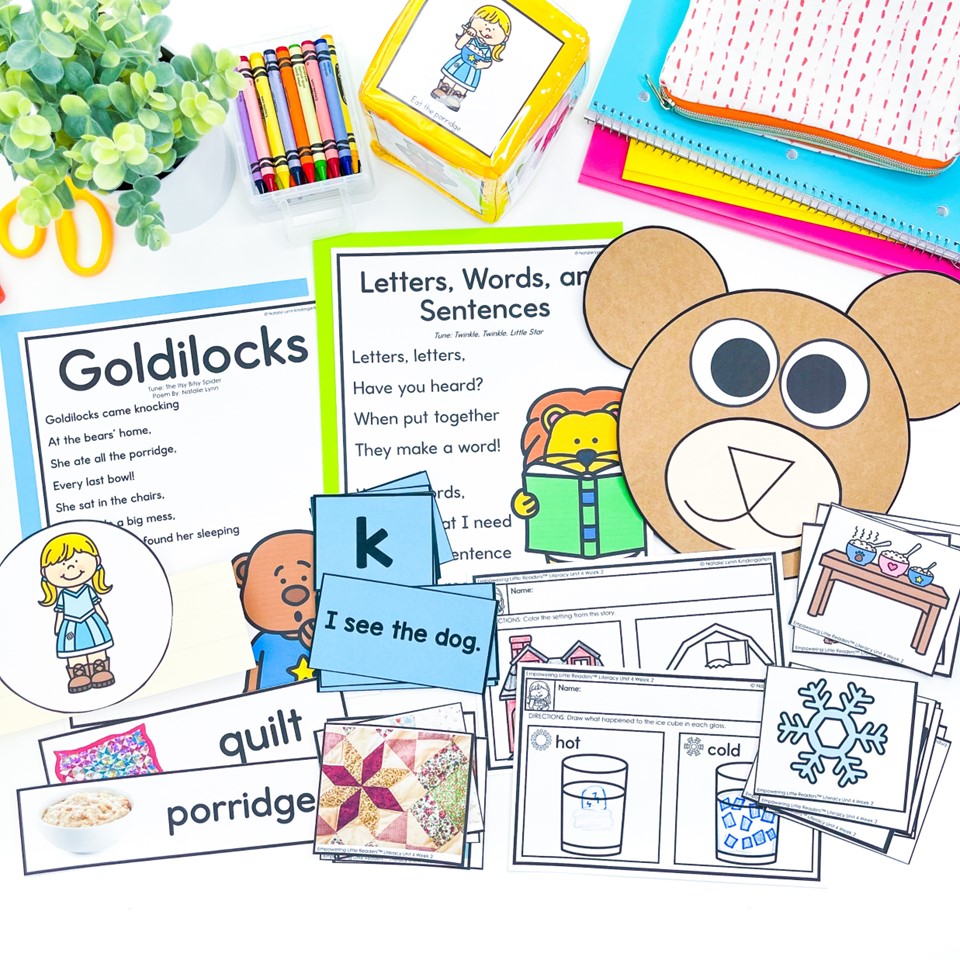
As the teacher, you have the freedom to spread these out throughout your day as you see fit.
The Preschool and Pre-K Literacy Curriculum includes:
- Oral language and vocabulary
- Phonological and phonemic awareness
- Concepts of print
- Whole group read aloud and comprehension
- Student worksheets
- Extend the learning with art
- Extend the learning with fine motor
- Extend the learning with gross motor
- Extend the learning with science or math
- Extend the learning with social emotional learning (SEL)
- Literacy center activities
Note: This curriculum does not include phonics and the alphabet. That is covered extensively in the Preschool and Pre-K Phonics Curriculum.
Let’s take a closer look at each of these components and what it will look like in your preschool or pre-k classroom.
Oral Language
Each day’s lesson plans include an oral language portion to help students build listening and speaking skills.
Incorporating lessons to build oral language is important because it teaches students how to understand and use academic vocabulary, which is essential to students’ language development as they advance to higher grade levels.
In fact, research tells us that students begin developing their reading comprehension before they ever learn to read!
How is this possible? By developing their oral language and listening comprehension skills – all things that the Preschool and Pre-K Literacy Curriculum focus on.
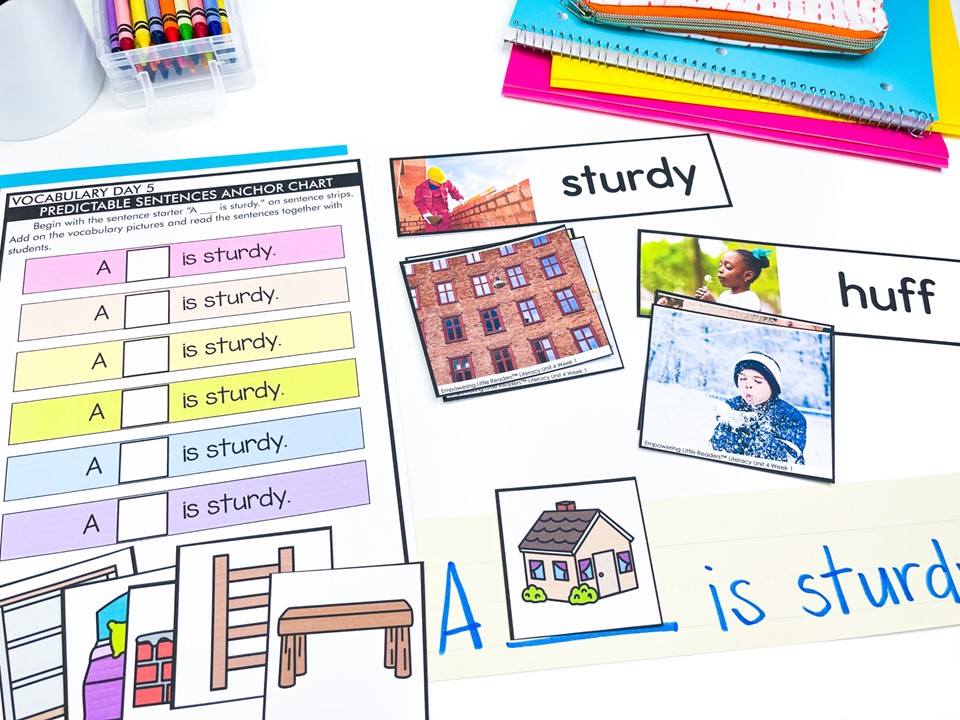
Some of the daily oral language activities in these read aloud lesson plans for preschool teachers include:
- singing songs
- teaching vocabulary
- using new vocabulary in context
Discussing new vocabulary words helps students build background knowledge in regard to the big idea for the week’s lessons.
Weekly Vocabulary Lessons
As a part of your oral language routine for preschool and pre-k, you will introduce 2 new vocabulary words a week.
Sometimes these will be two vocabulary words from the read aloud, and sometimes it will be one word from the read aloud and then it’s opposite or it’s homonym.
As a part of your weekly vocabulary lessons for preschool, you will:
- Introduce and discuss each word
- Sort real-life pictures that represent each word
- Use one of the words in patterned sentences for context
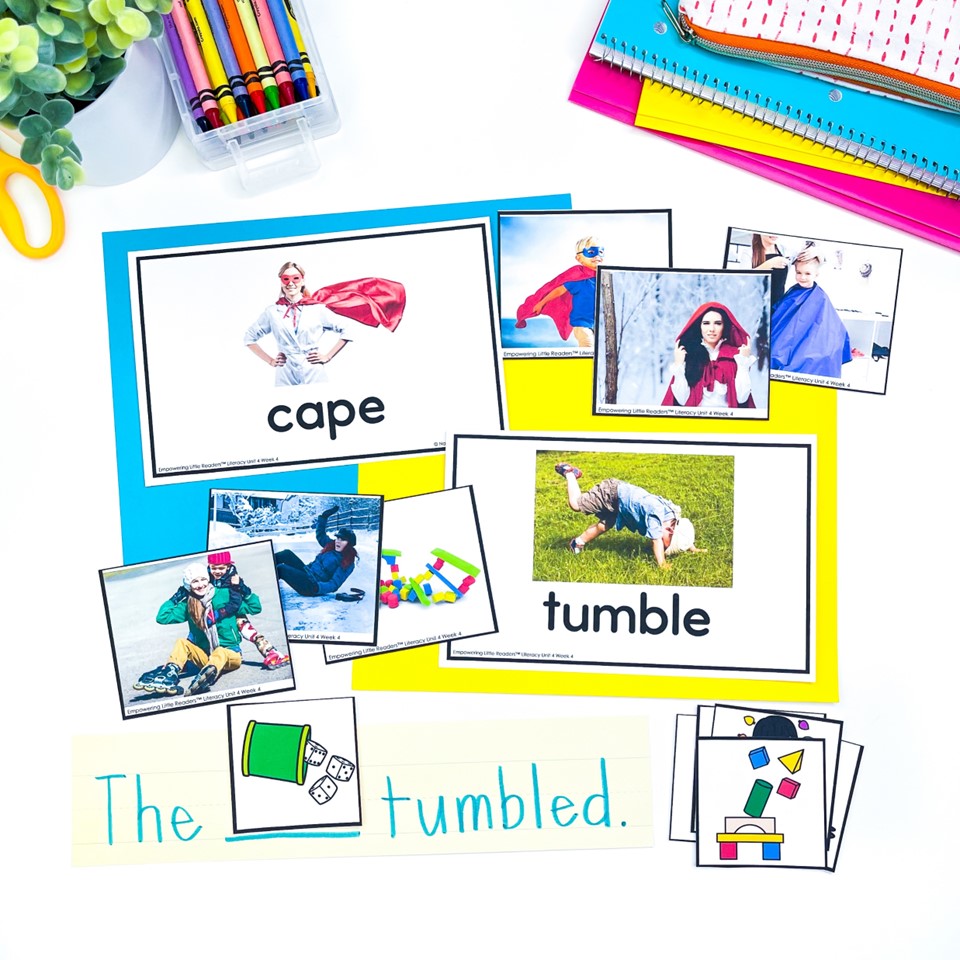
Phonological Awareness
We know that one of the pillars of a strong literacy foundation is phonological awareness. Each day you will have a short phonological awareness lesson that is short but packs a punch.
Part of our phonological and phonemic awareness routine will be reading a poem each day. All of the poems in the Preschool and Pre-K Literacy Curriculum are original poems written by me!
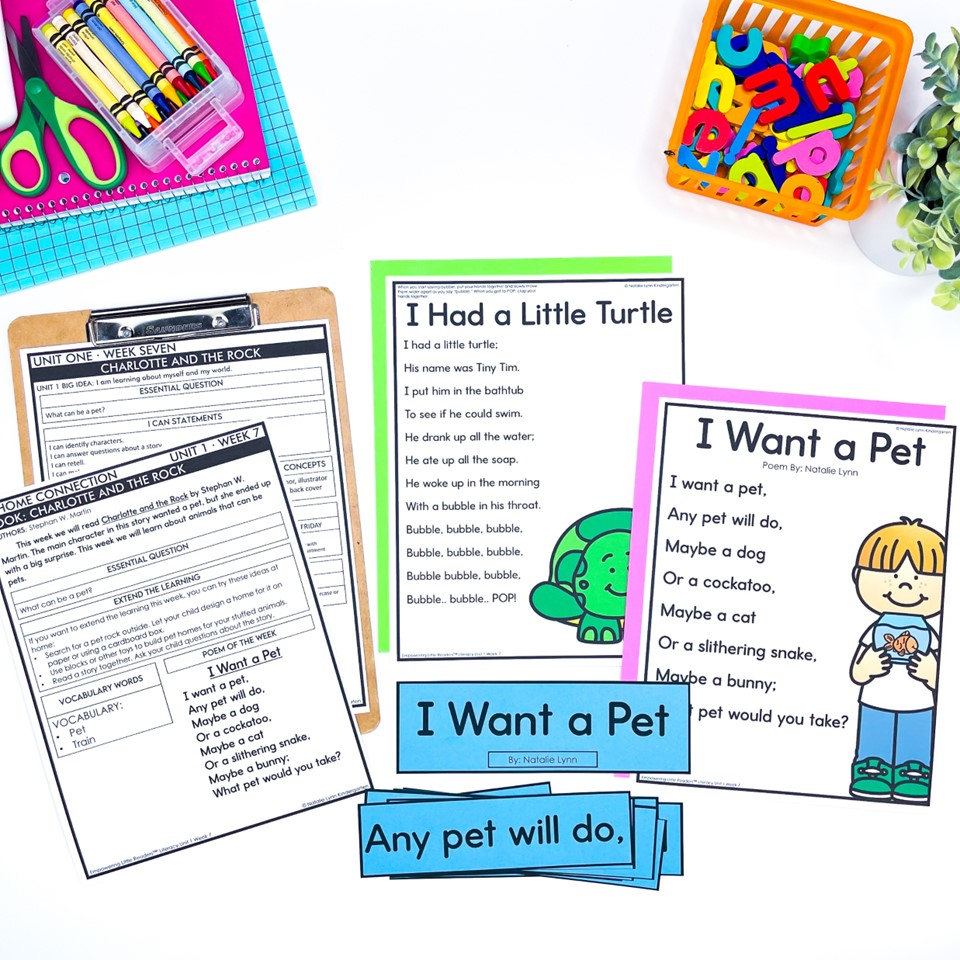
Each day, you will Mirror Read the poem together. This means that you will read a line, and then students will repeat after you.
Then, you will complete a short phonological and phonemic awareness activity that will take only 1-2 minutes.
The phonological awareness skills covered in each unit include:
- Repeating sounds and words
- Repeating sentences and counting words
- Rhyming
- Alliteration
- Syllables
- Onset and rime
- Blending words
- Segmenting words
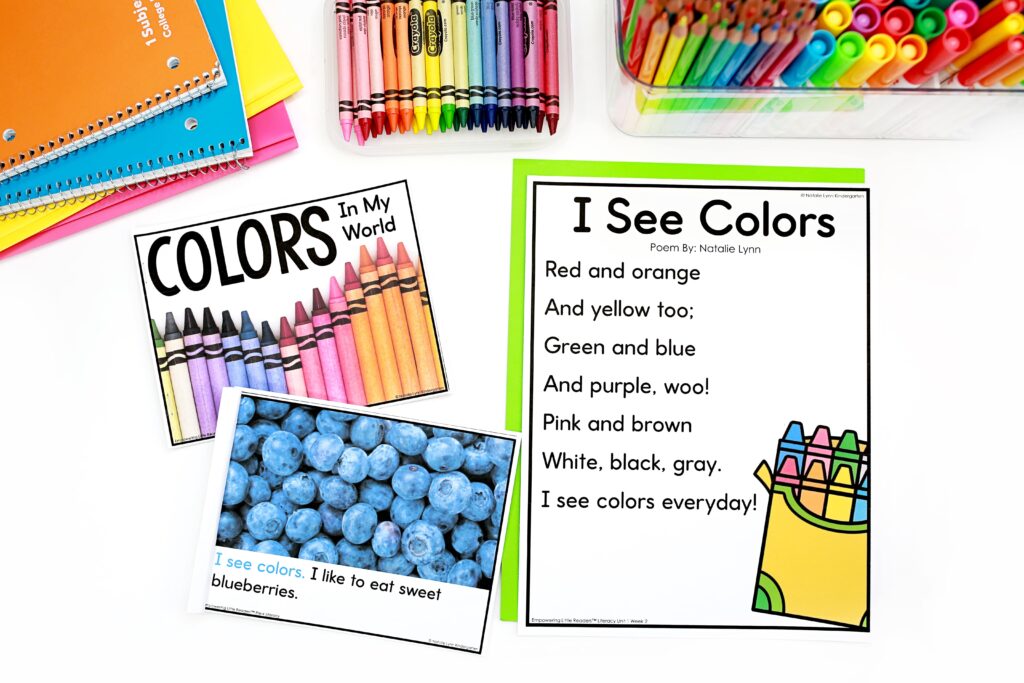
Print Concepts
In order to prepare our preschool students to eventually read a book independently, we must first familiarize them with print concepts such as the title, author, spine, and title page.
Providing young readers with the opportunity to identify these different parts of a book each time they listen to a text read aloud is important. Within my read aloud lesson plans for preschool I help you naturally introduce new print concepts to students.
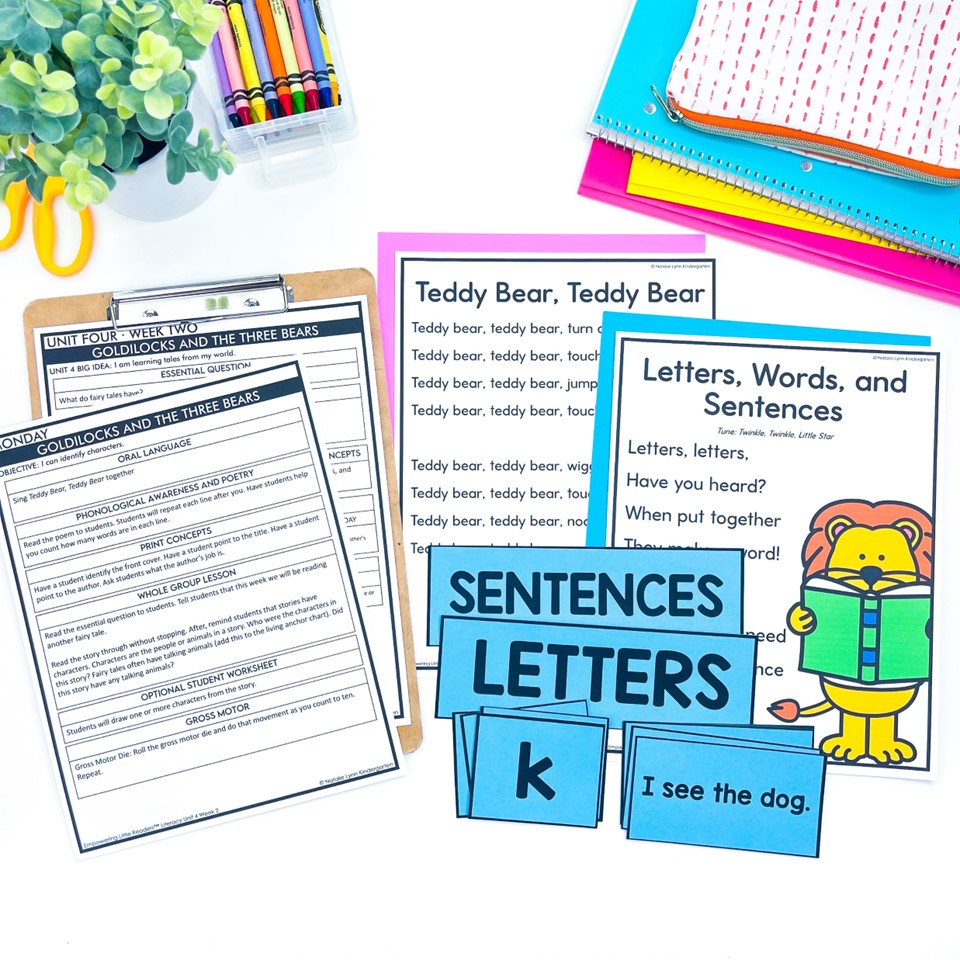
This includes singing original concepts of print songs and meaningful, hands-on practice for students!
The concepts of print covered in the Preschool and Pre-K Literacy Curriculum include:
- Parts of a book
- Title, author, and illustrator
- How to hold a book and turn the pages
- Pictures vs text
- Letters, words, and sentences
- Directionality
- Spaces
- Punctuation
- Pointing one to one
- Capital and lowercase letters
- Return sweep
Whole Group Read Aloud
Read alouds are so important for our beginning readers because they build listening comprehension and reading comprehension skills.
During interactive read alouds, the teacher takes on the brainwork of reading, which allows students to focus on listening to and comprehending the story.
For this curriculum, you will focus on one main read aloud each week. This allows your preschool and pre-k students to be exposed to the text multiple times and think about it in different ways.
There is also an original nonfiction book included each week related to the weekly theme.
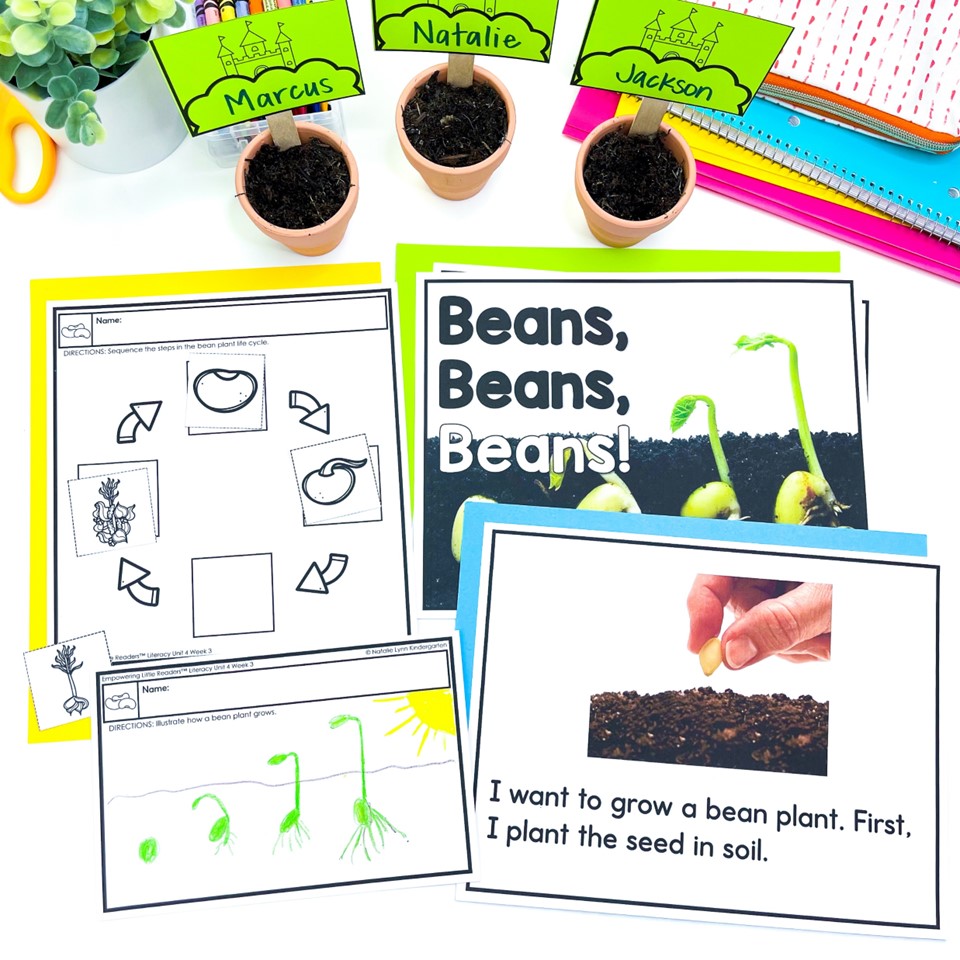
These nonfiction books are simple enough for preschool and pre-k students, but are packed with information and interesting pictures and details.
Comprehension
All great read aloud lesson plans for preschool include a comprehension focus. My motto for this time is: Keep it simple!
We will only focus on 1 reading comprehension skill each day.
Why? It’s like that saying, “Too many chefs in the kitchen spoils the broth.” Trying to hit on too many areas can weaken the overall lesson.
But that doesn’t mean you can’t work on multiple areas of reading comprehension with these read alouds for preschool! By reading the same book all week, you can work on a different comprehension skill each day.
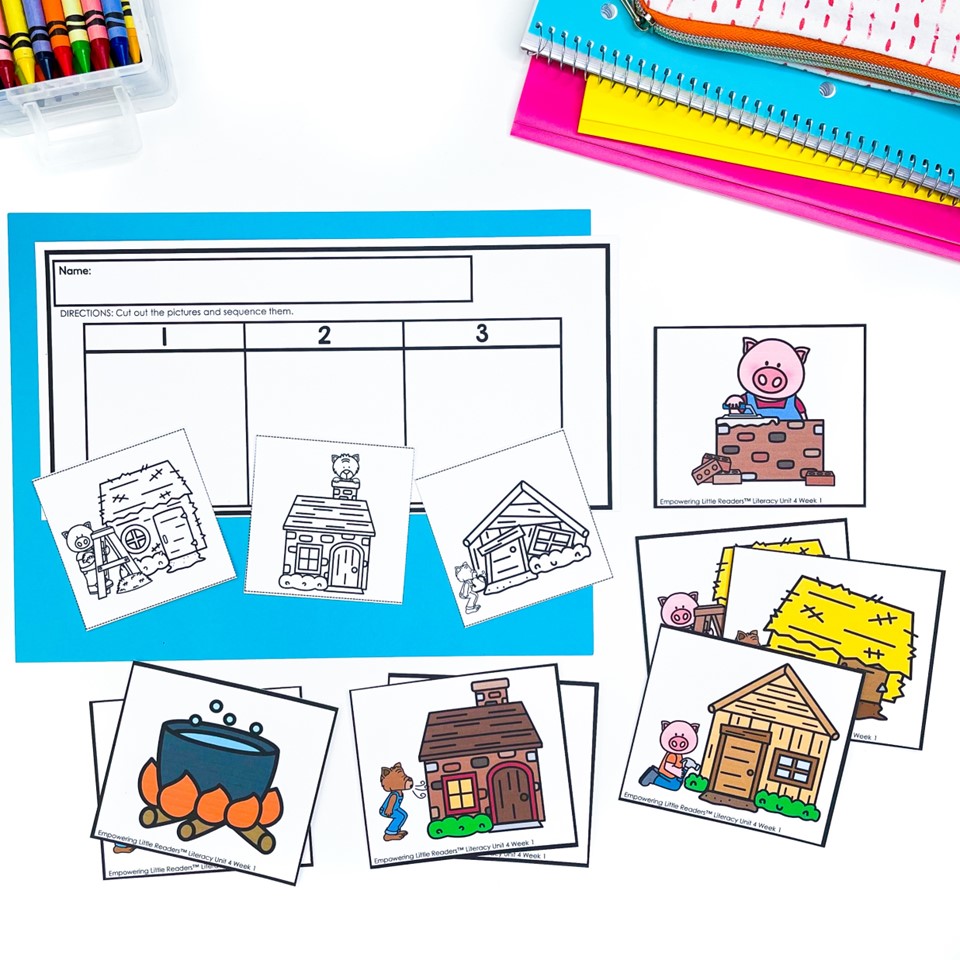
Some of the reading comprehension skills covered by the Preschool and Pre-K Literacy Curriculum include:
- Characters and setting
- Problem and solution
- Character feelings
- Main idea
- Retelling and sequencing
- Making connections
- Cause and effect
- Visualizing
- Making predictions
Writing to respond
In preschool, writing to respond to text doesn’t necessarily look like “writing” as we know it. Instead, writing may take the form of drawing or coloring to show mastery.

Differentiated worksheets are included so your students can color, draw, or write to answer the comprehension questions.
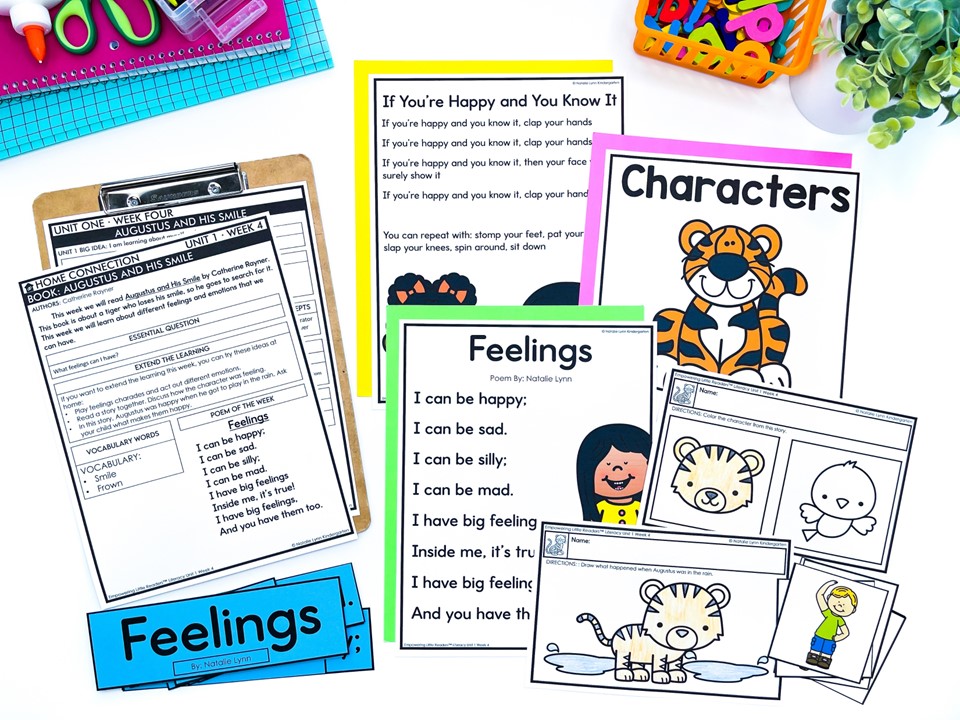
This makes it easy to use this literacy curriculum with a wide range of ages from preschool to pre-k to kindergarten!
Extend the Learning Activities
Providing opportunities to extend the learning happening in literacy via other subject areas allows students to make connections throughout their day. The Extend the Learning activities in the read aloud lesson plans for preschool rotate depending on the day of the week to allow students to have several opportunities for explicit instruction related to subjects other than literacy.
Generally, the Extend the Learning activities will follow this schedule:
Monday: Gross motor
Tuesday: Fine motor
Wednesday: Art
Thursday: Explore/STEM
Friday: SEL
Having a range of activities already planned allows students to extend their learning in a number of engaging ways without putting more on their teacher’s plate.
Gross Motor Activities
Gross motor activities for preschool involve the whole body and work the large muscle groups. These activities include things like jumping, twisting, hopping, and more.
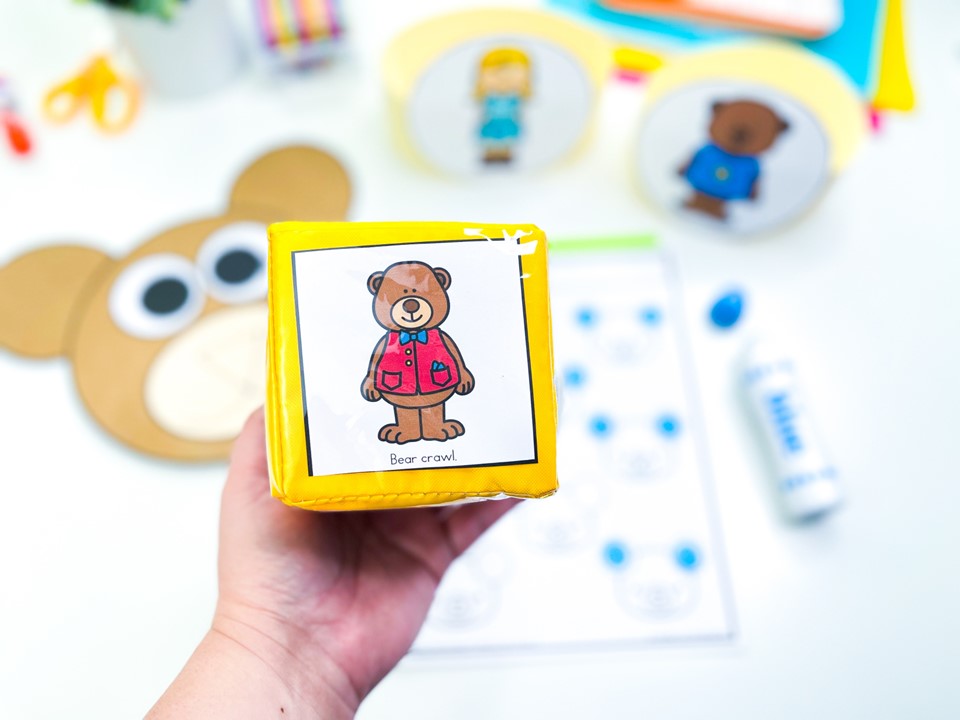
Some of the gross motor activities include:
- Gross motor dice roll and move
- Spin and move
- Exercise and count
While the gross motor activities are planned for day one, you may find that you want to continue them throughout the week as a warm up to your literacy lessons!
Fine Motor Activities
Fine motor activities work the small muscles in the wrists, hands, and fingers. Fine motor skills are essential for writing, cutting, and life skills, which makes this an important area to work on!
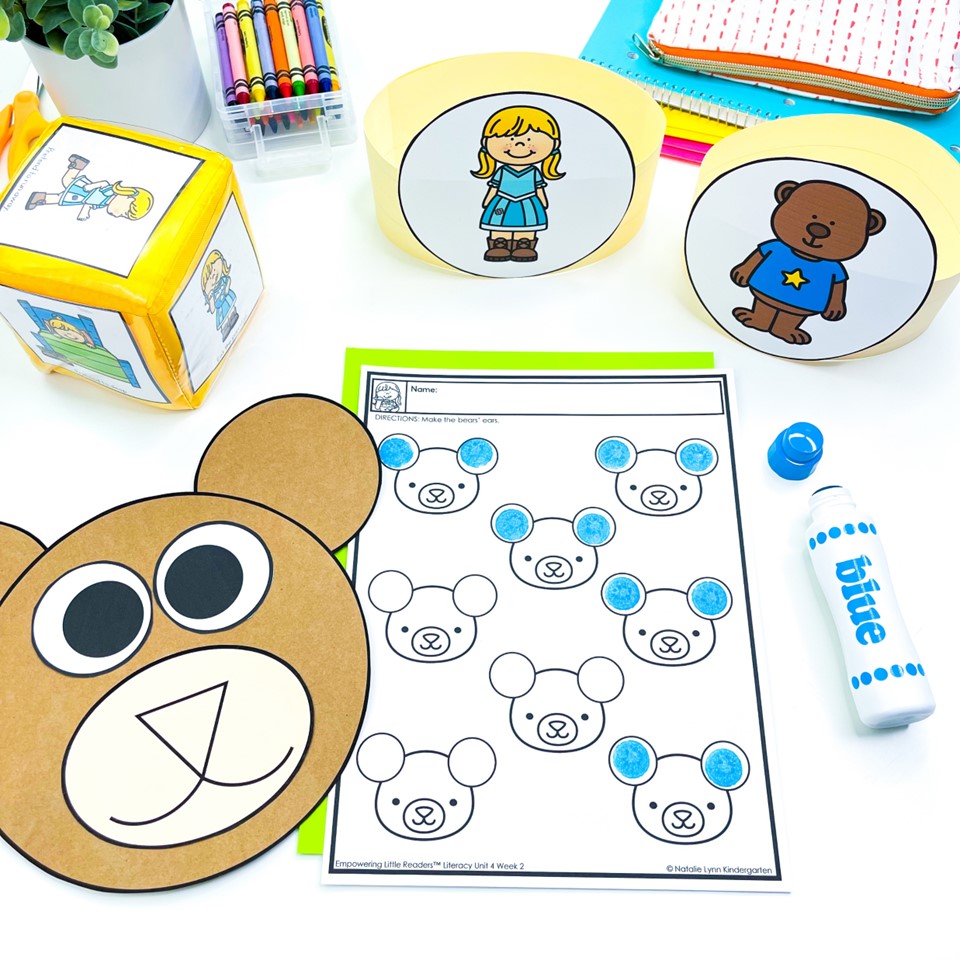
Some of the fine motor activities include:
- Cutting and gluing
- Dot markers
- Dotting paint
- Tracing
This will usually look like fine motor worksheets each week, but it will sometimes be a fine motor craft that practices multiple skills.
Art and Crafts
Art and crafts are so important in preschool and pre-k because they hit so many skills – from fine motor skills to listening and following directions to creative thinking.
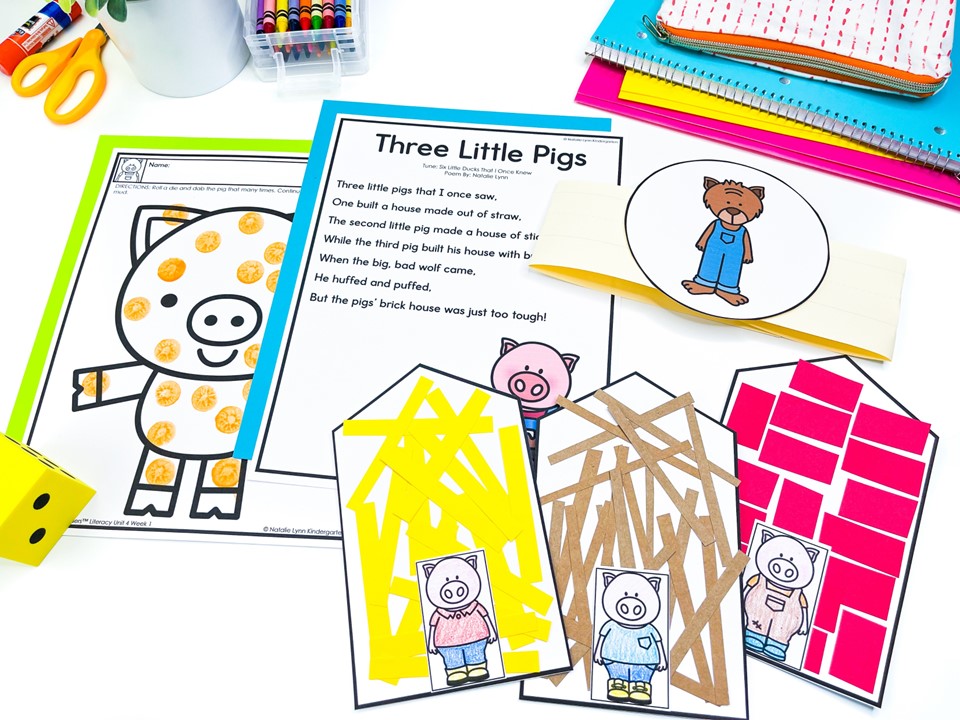
The Preschool and Pre-K Literacy Curriculum includes both fine motor crafts and process art projects to promote creativity and expression.
Explore
The Explore time usually covers science topics, but it may include math topics as well. This time will usually follow up the nonfiction read alouds.
During the explore portion, students may complete science experiments or further learn about the weekly theme topic.
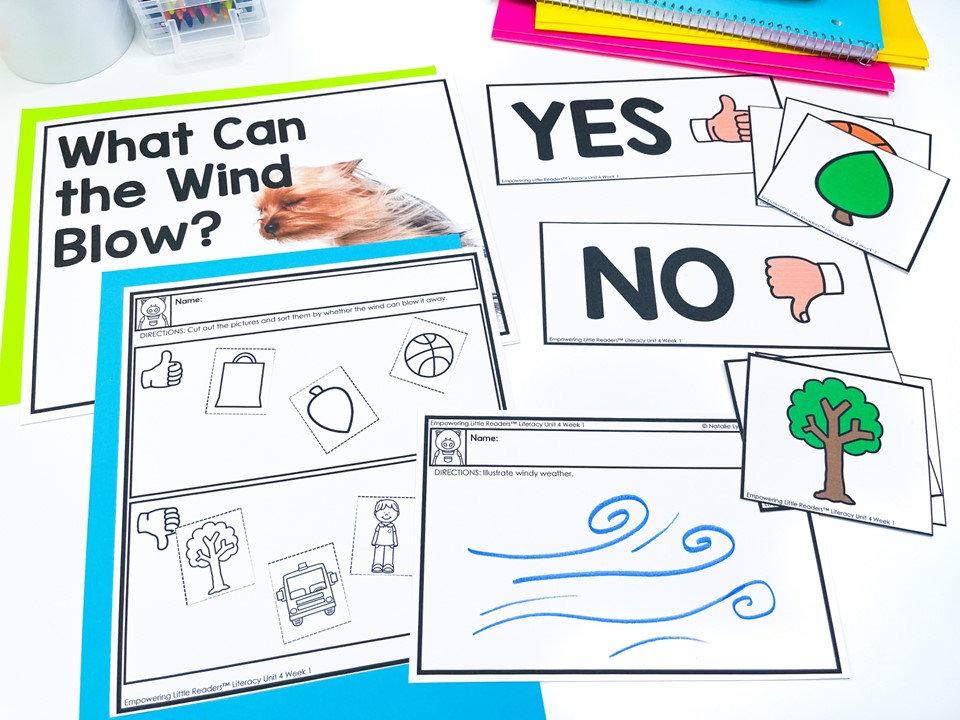
Some explore activities in this curriculum include:
- A listening walk
- What will the wind blow? science experiment
- Measuring bats
- Fizzy fire experiment
- and much, much more!
Social Emotional Learning
SEL, or social emotional learning, is a HUGE area that our preschool and pre-k students are developing at this point. I wanted to give you short and sweet SEL lessons that you could implement each week.
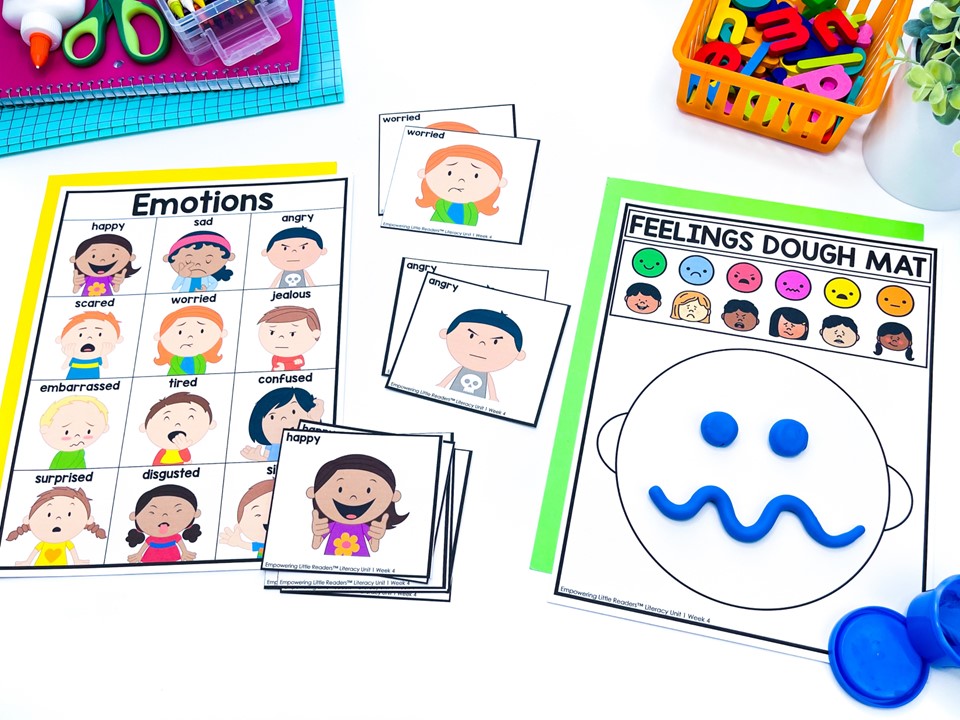
These SEL lessons are often related to the story in some way and cover skills such as:
- Feelings and emotions
- Being a good friend
- Respect and responsibility
- Having a conversation
- Waiting and taking turns
Center Activities
Providing students with hands-on ways to practice independently is important. Each week includes 2 literacy centers that match the weekly theme.
The literacy center activities included in my read alouds lesson plans for preschool help students gain extra practice with the alphabet, particularly forming, matching, and building the letters of the alphabet.
Some of the literacy centers include:
- Building letters with playdough
- Covering letters by code
- Matching letters
Ready to take the leap?
Ready to jump into a new literacy curriculum this school year? These read aloud lesson plans for preschool and pre-k are just what you need to get started.
Check out what other teachers are saying about this curriculum:
“I am LOVING this curriculum!! As a new PK teacher, I was a little lost with no curriculum to follow. This is super engaging for students and super easy for a teacher to use!” -Kristen D.
“Another amazing resource! So well organized, with lots of details are so many important focuses covered. I love that it breaks everything down and provides so many wonderful activities to go along with the lessons.” – Kristina G.
“I use this literacy curriculum during my morning circle time. I love that it includes gross motor, fine motor, arts and crafts and SEL in addition to literacy. My students have also loved the non-fiction text that is included with each lesson and I love how everything is already planned out for you.” -Chrisana H.
Looking for more Preschool and Pre-K Curriculums? Find them here:

